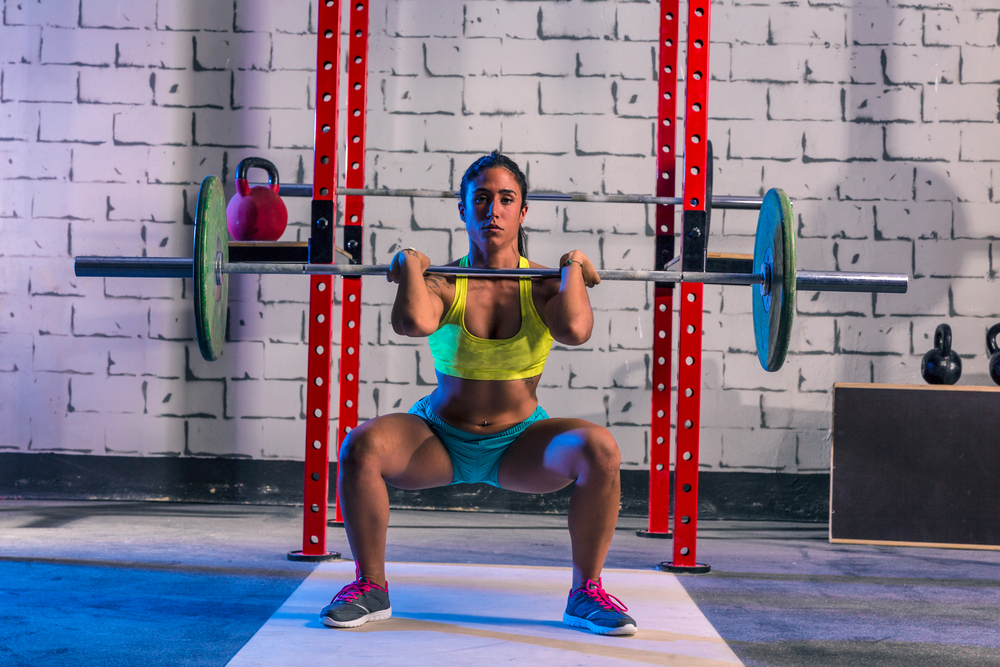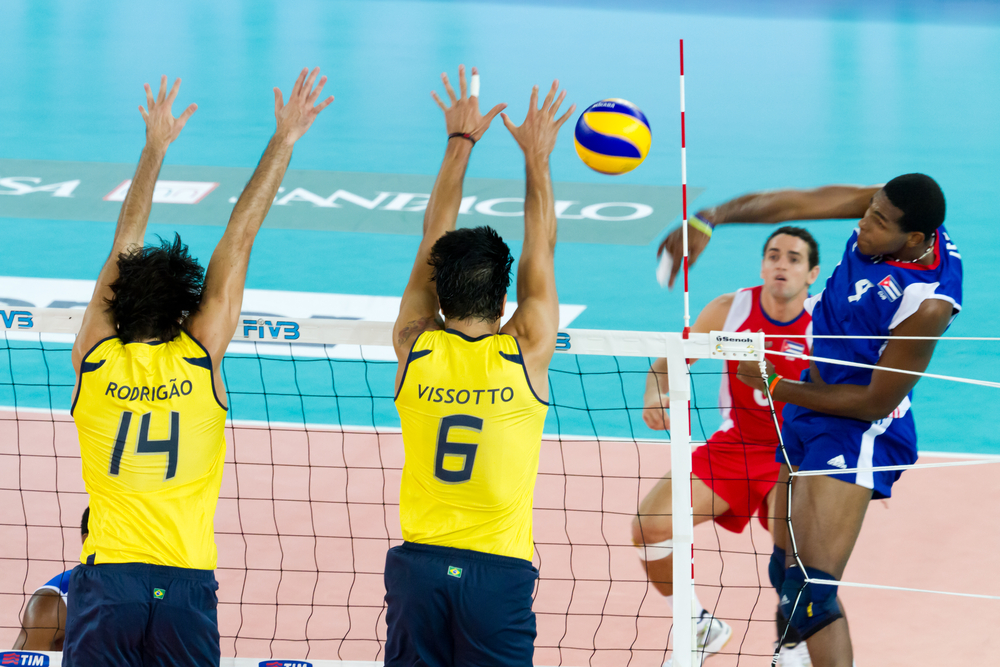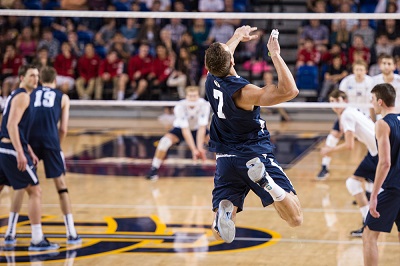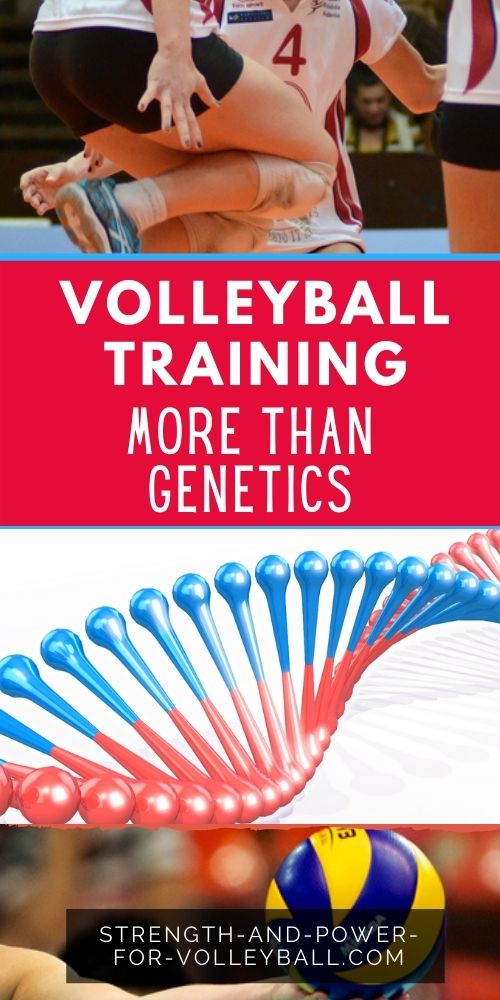- Home
- Smarter Training
- volleyball muscles
Volleyball Muscles
Do You Have Right Genetics to Excel?
Volleyball muscle fiber types and the best genes for volleyball.
Muscle Fiber Types
The nature of your sport determines the type of conditioning that should be undertaken to achieve the desired response.
One of the major goals of volleyball conditioning is to produce the muscular
strength and power needed to excel at volleyball.
The following is a basic explanation of how different athletes should use different modes of training
and how muscle fiber types fit into the equation.
What type of muscle are you training?
Not all muscle is the same.
Basically, athletes are made up of different types of muscle fibers.
Generally, muscle fibers are described as either fast-twitch or slow twitch.
A fast-twitch motor unit is one that develops force rapidly. It also relaxes rapidly and thus has a short twitch time.
Slow-twitch motor units develop force and relax slowly and have a long twitch time.
Volleyball Muscles and Genetics for Jump Serving
Slow Twitch vs Fast Twitch

Many people believe that having more fast and slow twitch muscle fibers
may determine what sports athletes excel at and how they respond to
training.
It is generally accepted that muscle fiber types can be broken down into two main types.
Slow twitch fibers (Type I) contract for long periods of time but
with little force while fast twitch fibers (Type II) contract quickly
and powerfully but fatigue very rapidly.
Muscles are predominately powered by the oxidation of fats and
carbohydrates, but anaerobic chemical reactions are also used,
particularly by fast twitch fibers.
These chemical reactions produce adenosine triphosphate (ATP) molecules
which are used to power the movement of the myosin heads.
An Australian research study in 2003 showed that having more slow twitch
muscle fibers improves a person's success in endurance activities while
more fast twitch muscle fibers appears to improve a person's ability to
excel in sprint or power sports.
Type I, IIa, and IIb Fibers

Type I fibers are generally fatigue resistant and have a high capacity for
aerobic energy supply, but they have a limited potential for rapid force
development.
Type II fibers are essentially the opposite of Type I. Type II are characterized
by fatiguability, low aerobic power, rapid force development, and high anaerobic
power.
To break it down even more, there's Type IIa and Type IIb.
Type IIa Fibers
These fast twitch muscle fibers are also known as intermediate fast-twitch fibers. They can use both aerobic and anaerobic metabolism almost equally to create energy. In this way, they are a combination of Type I and Type II muscle fibers.

Type IIa Muscle Fibers for Jumping High Late in the Tournament
Type IIb Fibers
These fast twitch fibers use anaerobic metabolism to create energy and
are the "classic" fast twitch muscle fibers that excel at producing
quick, powerful bursts of speed.
This muscle fiber has the highest rate of contraction (rapid firing) of
all the muscle fiber types, but it also has a much faster rate of
fatigue and can't last as long before it needs rest.
In most sports, both types are used with IIb contracting first.
For example, in a 1000 meter race, a speed skater would recruit Type IIb fibers first. Once fatigued, Type IIa would take over.
Fiber Type and Performance
Every athlete has a different percentage of fast or slow twitch muscle
fibers and our muscle fiber type influences what sports we are naturally
good at.
For example, professional athletes tend excel at sports that match their genetic makeup.
Relative Involvement of Muscle Fiber Types in Sport Events
| Event | Type I | Type II |
| 100-m sprint | Low | High |
| 800-m run | High | High |
| Marathon | High | Low |
| Olympic Weightlifting | Low | High |
| Barbell Squat | High | High |
| Soccer | High | High |
| Field Hockey | High | High |
| Football Wide Receiver | Low | High |
| Football Lineman | High | High |
| Basketball | Low | High |
| Distance Cycling | High | Low |
Olympic sprinters have been shown to possess about 80 percent fast twitch fibers, while those who excel in marathons tend to have 80 percent slow twitch fibers.
How Important is Fiber Type to Success in Volleyball?
Is fiber type the number one factor that makes an elite athlete elite?
Fiber type is part of a great athlete's success, but it alone is a poor predictor of performance.
You can train slow-twitch fibers to act fast.
When challenged properly, the human body has the capacity to make
significant changes, one of which is a change in how muscle fibers
function.
Research shows that it's possible to train a fast-twitch muscle fiber to behave like a slow-twitch muscle fiber, and vice versa.
However, both of these changes are difficult to bring about and require a great amount of work.
Type II Fibers Important for Approaching Fast, Jumping High, Spiking Hard
The Muscular System is like a Computer System
The muscular system is similar to a computer system in that what ever an
athlete puts into it is what the athlete gets out of it.
Muscles want to complete a task in the most efficient way they know how.
If the athlete only teaches their muscles to complete tasks slowly, that's what the athlete will get back.
It makes sense that an athlete who needs to compete at higher speeds needs to train the muscles to function optimally at these higher speeds.
Training at lower speeds will not be effective for developing explosive power for volleyball.
This is why a tennis player doesn't make six mile runs a regular part of training. This wouldn't make sense for a sport with such a large anaerobic component.
If you enjoyed these tips and would like to keep it close to you at any time, just save this pin to your Pinterest Volleyball Training Board.
Bottom line: To be fast, you must train fast.
Your volleyball strength and conditioning workout should include the proper
strength and explosive exercises for volleyball.
Exercise scientists define power as, "the optimal combination of speed and strength to produce movement."
Power is what enables the superstar running back to break tackles, the
Olympic sprinter to explode out of the blocks, and the tennis player
to serve ace after ace.
Power is what separates winners from losers, and it's power that will make you a
winner in volleyball.

